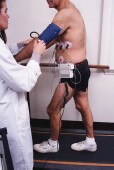
TUESDAY, Feb. 5 (HealthDay News) — The blood pressure drug ramipril may make walking a bit easier for people with clogged leg arteries, new study results suggest.
Researchers found that of 212 people with peripheral artery disease (PAD), those given ramipril every day for nearly six months were faring better on their feet than those on inactive placebo pills.
On average, they could walk on a treadmill 4 minutes longer, and got an extra 75 seconds of pain-free walking.
That might not sound like a big difference. But it beats the benefits of the two drugs approved in the United States for improving PAD patients’ ability to walk, according to Dr. Mary McGrae McDermott, a professor of medicine at Northwestern University Feinberg School of Medicine in Chicago.
It’s also similar to the effects of supervised exercise therapy — another standard PAD treatment, said McDermott, who wrote an editorial published with the study in the Feb. 6 issue of the Journal of the American Medical Association.
Ramipril is sold under the brand-name Altace in the United States, but it is also available as a generic.
And that’s a selling point for using it to treat PAD-related walking problems, according to study leader Anna Ahimastos. It may not only be effective, but also inexpensive, said Ahimastos, a researcher with the Baker IDI Heart and Diabetes Institute at Alfred Hospital in Melbourne, Australia.
One thing that’s not clear, according to McDermott, is how well improvements in treadmill walking translate into real life.
“Treadmill walking performance is not likely to be a precise surrogate for people’s daily functioning or quality of life,” she said.
Still, she added, the patients on ramipril did score higher on a quality-of-life questionnaire. They also said their walking speed and ability to climb stairs had improved, while the placebo users did not.
So that’s some evidence the drug may improve people’s day-to-day functioning, McDermott said.
Ahimastos said that for some people, the improvement could mean the difference between being able to run an errand close to home or needing to have someone else do it.
In the United States, about 8 million people have PAD, which usually arises when atherosclerosis, a hardening and narrowing of the arteries, restricts blood flow to the legs. The main symptoms are leg pain or cramps that arise during walking or other normal activities — though not everyone with PAD has that problem.
Right now, there are two drugs approved in the United States for boosting PAD patients’ walking ability: pentoxifylline (Pentoxil, Trental) and cilostazol (Pletal), which typically only increase people’s walking distance by about 15 to 25 percent.
Ramipril is an ACE inhibitor — a group of drugs used for high blood pressure and chronic heart failure. It’s not clear why the medication would improve walking ability, but it may be due to improved blood circulation or better muscle function, according to Ahimastos.
Another unknown is whether other ACE inhibitors could help treat PAD, because the drugs vary in how they act in the body.
“They are not all identical,” McDermott said. Based on animal research, she added, some ACE inhibitors may affect muscle function, while others may not.
No one knows whether other blood pressure drugs might help, either. McDermott said that one other class of blood pressure drug — angiotensin II receptor blockers — may affect muscle function.
But that’s based on lab research, and McDermott said it’s too early to tell whether the medications, which include brand-names like Diovan and Benicar, might help people with PAD.
It’s also hard to know how many people with PAD and walking problems could benefit from ramipril. The patients in the new study had fairly well-controlled blood pressure, and most were free of diabetes. In the real world, many people with PAD may already be on an ACE inhibitor, because many have high blood pressure or diabetes.
Ramipril can cause side effects. About 7 percent to 8 percent of the study patients on ramipril complained of a chronic cough or dizziness — which are two of the most common side effects of the drug.
Still, those effects are tolerable for a lot of people. And McDermott said it might be worthwhile to ask your doctor about the pros and cons of the drug. “Patients with PAD and (leg pain) may want to discuss ramipril with their doctor as a potential therapeutic option to improve their walking,” she said.
The study was funded by the National Heart Foundation of Australia and government grants. Several of the study authors reported ties with drug companies.
More information
Learn more about peripheral artery disease from the American Heart Association.

